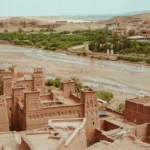The best time to visit Morocco depends on your travel priorities and regional preferences, as this diverse North African destination experiences dramatic climate variations from Mediterranean coastlines to Sahara desert landscapes. Understanding seasonal weather patterns helps travelers optimize their Morocco experience while avoiding extreme temperatures and crowds.
Morocco’s strategic location creates distinct seasonal patterns that significantly impact travel comfort, activity options, and overall satisfaction. The country’s geography ranges from snow-capped Atlas Mountains to scorching desert regions, making timing crucial for a successful visit.
Best Time to Visit Morocco: Overview
The optimal months for most travelers are April-May and September-November, offering comfortable temperatures averaging 21-30°C across most regions. These seasons are the best time to travel Morocco as they provide the perfect balance of pleasant weather, manageable crowds, and reasonable accommodation prices.
Peak season benefits include minimal rainfall, clear skies, and ideal conditions for both outdoor adventures and cultural exploration. Spring brings wildflower blooms in the Atlas Mountains, while fall offers crystal-clear desert nights perfect for stargazing.
Regional considerations are essential when determining the best time of year to go to Morocco, as coastal areas, imperial cities, and desert regions each have distinct climate patterns. What works for Marrakech exploration might be challenging for Ouarzazate or Sahara adventures.
Morocco Weather by Month: Seasonal Breakdown
- Spring (March-May): Ideal Travel Season
March marks the transition from cool winter to pleasant spring conditions, with temperatures ranging from 18-24°C in cities like Marrakech and Fez. The Atlas Mountains and Ouarzazate city begin warming while desert regions become comfortable for camel trekking and overnight camping.
April represents one of the best times to go to Morocco, offering near-perfect weather conditions across all regions. Wildflowers bloom throughout the mountains, rainfall decreases significantly, and temperatures support comfortable all-day exploration.
May continues excellent spring conditions with slightly warmer temperatures that remain pleasant for most travelers. This month marks the end of the rainy season, ensuring clear skies and excellent visibility for photography and sightseeing.
- Summer (June-August): Hot but Manageable
Summer brings intense heat to inland areas, with temperatures frequently exceeding 38°C in cities like Ouarzazate, Marrakech and Fez. However, coastal regions like Essaouira and Casablanca remain moderate due to Atlantic Ocean breezes.
Travel strategies for summer include focusing on coastal areas, timing activities for early morning or late afternoon, and ensuring accommodations have air conditioning. Despite the heat, summer offers advantages including lower prices and fewer crowds at major attractions.
- Fall (September-November): Peak Travel Season
September marks an excellent return to comfortable conditions as temperatures moderate from summer extremes while maintaining warm, pleasant weather. Evening temperatures become ideal for outdoor dining and cultural activities.
October arguably offers the best time of year to visit Morocco, with perfect weather conditions across all regions. Temperatures range from 21-29°C, rainfall remains minimal, and conditions favor everything from desert adventures to mountain hiking.
November continues the excellent fall pattern, though temperatures begin their gradual winter decline. This month offers fewer tourists as European visitor numbers decrease, leading to more authentic cultural experiences.
- Winter (December-February): Cool but Pleasant
Winter brings notably cooler temperatures, with daytime highs ranging from 15-21°C in most areas. While cooler than other seasons, these temperatures are actually quite pleasant for walking and sightseeing in sunny conditions.
Winter advantages include minimal crowds, lower accommodation prices, and authentic cultural experiences without tourist pressure. Desert travel becomes particularly appealing as daytime temperatures turn comfortable while nights offer spectacular stargazing opportunities.
Regional Climate Considerations
- Imperial Cities vs. Coastal Areas
Marrakech and Fez experience semi-arid climates with hot summers and mild winters. The best months for imperial city exploration are April-May and September-November when medina walking remains comfortable throughout the day.
Ouarzazate, experiences a distinctive desert climate with dramatic temperature variations between day and night. Located at the edge of the Sahara Desert and near the High Atlas Mountains, the city sees winter daytime temperatures averaging 17°C but dropping to 2°C at night.
Summer in Ouarzazate can be hot, with July temperatures reaching 39°C during the day and cooling to 23°C at night. The best time to visit Ouarzazate is March-May and September-November when temperatures range from 23-29°C, making it comfortable for exploring the famous kasbahs and film studios.
Coastal cities like Essaouira benefit from maritime influences that moderate temperatures year-round. The Atlantic coast offers refuge during summer months when inland areas become uncomfortable, with ocean breezes providing natural cooling.
- Desert and Mountain Regions
Sahara Desert timing requires careful consideration, with October through April offering the best conditions for camel treks and desert camping. Summer desert travel can be dangerous due to extreme heat, while winter nights become surprisingly cold.
Atlas Mountains provide cooler alternatives during hot summer months, though hiking should be planned for early morning or late afternoon. Spring and fall offer ideal mountain exploration conditions with comfortable temperatures and clear visibility.




